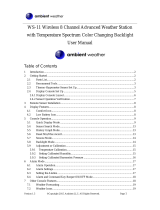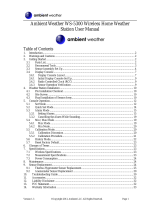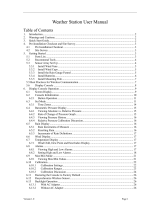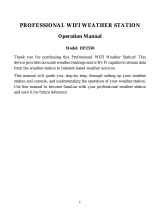Page is loading ...

Version 1.3 ©Copyright 2018, Ambient LLC. All Rights Reserved. Page 1
WS-12 Wireless 8 Channel Professional Weather Station
with Temperature Spectrum Color Changing Backlight
User Manual
Table of Contents
1 Introduction ............................................................................................................................... 2
2 Warnings ................................................................................................................................... 2
3 Quick Start Guide ...................................................................................................................... 3
4 Getting Started .......................................................................................................................... 3
4.1 Parts List ........................................................................................................................... 3
4.2 Recommend Tools ............................................................................................................ 5
4.3 Anemometer Assembly Sensor Set Up ............................................................................. 5
4.4 Rain Gauge Assembly Set Up .......................................................................................... 6
4.5 Thermo-Hygrometer Sensor Set Up ................................................................................. 8
4.6 Display Console ............................................................................................................. 10
4.6.1 Display Console Layout .............................................................................................. 10
4.6.2 Display Console Set Up ............................................................................................. 12
4.6.3 Sensor Operation Verification .................................................................................... 13
5 Weather Station Installation .................................................................................................... 14
5.1 Pre-Installation Checkout ............................................................................................... 14
5.2 Site Survey ..................................................................................................................... 14
5.3 Best Practices for Wireless Communication .................................................................. 15
6 Final Sensor Installation .......................................................................................................... 15
6.1 Anemometer Installation ................................................................................................ 15
6.2 Rain Gauge Installation .................................................................................................. 18
6.3 Thermo-Hygrometer Installation .................................................................................... 19
7 Console Operation................................................................................................................... 20
7.1 Quick Display Mode ...................................................................................................... 20
7.2 Set (Program) Mode ....................................................................................................... 21
7.3 Restore Factory Default.................................................................................................. 23
7.4 Channel Selection ........................................................................................................... 24
7.5 Sensor Search Mode ....................................................................................................... 24
7.6 History Graph Mode ....................................................................................................... 24
7.7 Reset Min/Max record .................................................................................................... 25
7.8 Snooze Mode .................................................................................................................. 25
7.9 Backlight Mode .............................................................................................................. 25

Version 1.3 ©Copyright 2018, Ambient LLC. All Rights Reserved. Page 2
7.10 Adjustment or Calibration .............................................................................................. 26
7.10.1 Temperature Calibration......................................................................................... 26
7.10.2 Humidity Calibration ............................................................................................. 27
7.10.3 Wind Speed, Rainfall and Barometric Pressure Calibration .................................. 27
8 Alarm Mode ............................................................................................................................ 29
8.1 Alarm Operation ............................................................................................................. 29
8.2 Viewing the High and Low Alarms ................................................................................ 29
8.3 Setting the Alarms .......................................................................................................... 30
8.4 Alarm and Command Key Beeper ON/OFF Mode ........................................................ 31
9 Other Console Features ........................................................................................................... 31
9.1 Feels Like Temperature .................................................................................................. 31
9.2 Moon Phase .................................................................................................................... 33
9.3 Personalizing Color Ranges ........................................................................................... 33
9.4 Low Battery Icon ............................................................................................................ 33
10 Glossary of Terms ............................................................................................................... 34
11 Specifications ..................................................................................................................... 34
11.1 Wireless Specifications ....................................................................................................... 34
11.2 Measurement Specifications ............................................................................................... 35
11.3 Power Consumption ............................................................................................................ 35
12 Troubleshooting Guide ............................................................................................................... 35
13 Maintenance ....................................................................................................................... 37
14 Accessories ......................................................................................................................... 37
15 Liability Disclaimer ................................................................................................................... 37
16 FCC Statement ........................................................................................................................... 38
17 Warranty Information ................................................................................................................. 39
1 Introduction
Thank you for your purchase of the WS-12 Wireless 8 Channel Professional Weather Station with
Temperature Spectrum Color Changing Backlight. The following user guide provides step by step
instructions for installation, operation and troubleshooting. To download the latest manual and
additional troubleshooting tips, please visit:
http://ambientweather.wikispaces.com/ws12
2 Warnings
Warning: Any metal object may attract a lightning strike, including your weather station
mounting pole. Never install the weather station in a storm.
Warning: Installing your weather station in a high location may result in injury or death.
Perform as much of the initial check out and operation.

Version 1.3 ©Copyright 2018, Ambient LLC. All Rights Reserved. Page 3
3 Quick Start Guide
Step
Description
Section
1
Assemble and power up the sensors
4.1- 4.5
2
Power up the display console and synchronize with wind sensor, rain
sensor and thermo-hygrometer sensor(s)
4.6
3
Mount the sensors
6
4
Set date and time on console
7.2
5
Calibrate the relative or sea-level pressure (barometer)
7.10.3
6
Clear any total rain that may have accumulated during the set up.
7.1
4 Getting Started
The WS-12 weather station consists of a display console (receiver), a sensor array with
thermo-hygrometer, rain gauge, wind sensor, and mounting hardware.
4.1 Parts List
QTY
Item
Image
1
Display Console
Frame Dimensions
(LxHxW):7.7X1.3X5.4 in
LCD Dimensions (LxW): 5.1 x 4.3 in
1
Thermo-hygrometer transmitter
(FT007TH)
Dimensions (LxHxW): 4.5 x 2.0 x 0.75in
1
Rain Gauge (WS-12-RG)
Dimensions: 8 1/4" x 7 3/4" x 5" (5"
diameter)

Version 1.3 ©Copyright 2018, Ambient LLC. All Rights Reserved. Page 4
QTY
Item
Image
1
Rain Gauge Filter
Dimensions: 2.48 x 2.48 x 1.1in
1
Anemometer (WS-12-WV)
Dimensions: 3 ¼ x 6 x 8 ½”
1
Anemometer Mounting Bracket (with pole
insert)
Dimensions: 3 x 4 x 1 ½”
1
Anemometer Mounting Bracket Back
Plate (pole mount)
Dimensions: 3 x 3 x 1 ”
1
Anemometer Pole
Dimensions: 12 x 1½ x 1”
2
Pole mounting U-bolt / nuts (M5)
4
Pole mounting nuts (M5) / bolts (∅5)
2
Pole mounting nuts (M3) / bolts (∅3)
4
Tapping screws

Version 1.3 ©Copyright 2018, Ambient LLC. All Rights Reserved. Page 5
QTY
Item
Image
1
Manual
1
Power Adapter
Figure 1
4.2 Recommend Tools
Phillips Precision screwdriver Size: PH0 and PH2
Compass or GPS (for wind direction calibration)
Adjustable Wrench
Hammer and nail for hanging remote thermo-hygrometer transmitter.
4.3 Anemometer Assembly Sensor Set Up
The anemometer assembly consists of the wind cups, wind vane, solar panel, bubble level, sensor
mounting bracket and mounting foot. The solar panel provides power to the anemometer when the
sun is out, and the batteries provide power at night (the solar panel does not charge the batteries).
Figure 2

Version 1.3 ©Copyright 2018, Ambient LLC. All Rights Reserved. Page 6
Locate the battery door on the anemometer transmitter, push and open the battery compartment, as
shown in Figure 3.
Figure 3
Insert four batteries into the battery compartment, then press the reset button, as shown in Figure
4.
Note: Use high quality alkaline batteries, which have an operational temperature range of -4
to 140 °F. Use Energizer e2 Lithium batteries for low temperature installation, which have an
operational temperature range of -40 to 140 °F. Do not use rechargeable batteries. They have a
lower operating voltage and discharge faster than non-rechargeable batteries, and will result in
short transmission ranges.
Figure 4
4.4 Rain Gauge Assembly Set Up
The rain gauge consists of the rain gauge funnel, base, and drawer filter, as shown in Figure 5.

Version 1.3 ©Copyright 2018, Ambient LLC. All Rights Reserved. Page 8
Figure 7
4.5 Thermo-Hygrometer Sensor Set Up
Remove the battery door on the back of the sensor by removing the set screw, as shown in Figure
8.
Figure 8
1. BEFORE inserting the batteries, locate the dip switches on the inside cover of the lid of
the transmitter.
Figure 9 displays all four switches in the OFF position (factory default setting).

Version 1.3 ©Copyright 2018, Ambient LLC. All Rights Reserved. Page 9
Figure 9
Channel Number: The WS-11 supports up to eight transmitters. To set each channel number
(the default is Channel 1), change Dip Switches 1, 2 and 3, as referenced in Table 1.
Temperature Units of Measure: To change the transmitter display units of measure (°F
vs. °C), change Dip Switch 4, as referenced in Table 1.
DIP SWITCH
FUNCTION
1
2
3
4
DOWN
DOWN
DOWN
---
Channel 1
DOWN
DOWN
UP
---
Channel 2
DOWN
UP
DOWN
---
Channel 3
DOWN
UP
UP
---
Channel 4
UP
DOWN
DOWN
---
Channel 5
UP
DOWN
UP
---
Channel 6
UP
UP
DOWN
---
Channel 7
UP
UP
UP
---
Channel 8
---
---
---
DOWN
°F
---
---
---
UP
°C
Table 1
2. Insert two AAA batteries.
3. After inserting the batteries, the remote sensor LED indicator will light for 4 seconds, and
then flash once per 60 seconds thereafter. Each time it flashes, the sensor is transmitting
data.
4. Verify the correct channel number (CH) and temperature units of measure (°F vs. °C) are
on the display, as shown in Figure 10.

Version 1.3 ©Copyright 2018, Ambient LLC. All Rights Reserved. Page 10
Figure 10
(1) temperature
(2) temperature units (°F vs. °C)
(3) channel number
(4) relative humidity
5. Close the battery door. Make sure the gasket (around the battery compartment) is properly
seated in its trace prior to closing the door. Tighten the set screw.
4.6 Display Console
4.6.1 Display Console Layout
The display console layout is shown in Figure 11.
Note: The following illustration shows the full segment LCD display for description purposes
only and will not appear like this during normal operation.

Version 1.3 ©Copyright 2018, Ambient LLC. All Rights Reserved. Page 11
Figure 11
1. Indoor temperature and humidity display
2. Indoor temperature and humidity HI/LO
alarm icon
3. Pressure (REL and ABS) display
4. Pressure units of measure
5. Feels like and dew point display
6. Temperature units (°F or °C)
7. Feels like and dew point HI/Lo alarm icon
8. Outdoor temperature and humidity
display
9. Humidity units of measure (%)
10. Outdoor temperature and humidity
HI/LO alarm icon
11. Channel 1-8 indicator
12. Scroll mode indicator
13. Low power indicator
14. Signal search icon
15. Wind direction
16. Wind gust HI alarm icon
17. Wind speed units of measure
18. Wind gust display
19. Wind speed average display
20. Wind speed average HI alarm icon
21. Rainfall display (1h, 24h, week, month, total)
22. Rainfall units of measure
23. Time alarm icon
24. Time and date
25. Temperature, humidity, wind speed, rainfall
and pressure history display icon
26. Min/Max reset for 24h
27. Time format of history graph (24h or 72h)
28.Temperature, humidity, wind speed, rainfall and
pressure variation in past 24h or 72h
29. Moon phase

Version 1.3 ©Copyright 2018, Ambient LLC. All Rights Reserved. Page 12
4.6.2 Display Console Set Up
Note: Power up the rain gauge, anemometer and thermos-hygrometer sensors first before
powering up the console. If you power up the console first, you will need to resynchronize the
sensors.
Make certain the weather station sensors are at least 10’away from the console and within
100’of the console. If the weather station is too close or two far away, it may not receive a proper
signal. If you have more than one thermo-hygrometer transmitter, make sure they are all powered
up and transmitting on different channels.
1. Remove the battery door on the back of the console, as shown in Figure 12.
2. Insert four AA batteries in the back of the display console. The display will beep once and all of
the LCD segments will light up for a few seconds to verify all segments are operating properly.
The console will cycle through a spectrum of colors.
Note: The character contrast is best viewed from a slightly elevated angle.
Figure 12
3. Replace the battery door, and fold out the desk stand and place the console in the upright
position.
The console will instantly display indoor temperature, humidity, pressure, moon phase and
time. The wind speed, wind gust, wind direction, rain, outdoor temperature and humidity will
update on the display within a few minutes. Do not Press any menu buttons until the outside
transmitter reports in, otherwise the outdoor sensor search mode will be terminated. When
the outdoor transmitter data has been received, the console will automatically switch to the
normal mode from which all further settings can be performed.

Version 1.3 ©Copyright 2018, Ambient LLC. All Rights Reserved. Page 13
While in the search mode, the remote search icon will be constantly displayed.
If you have more than one thermo-hygrometer sensor (up to eight thermo-hygrometer sensors
are supported), the display will automatically toggle between sensors until all sensors have
reported in.
If it does not update, please reference the troubleshooting guide in Section 13.
Note: The power adapter is intended to be correctly oriented in a vertical or floor
mounted position. The prongs are not designed to hold the plug in place if it is plugged into a
ceiling, under-the-table or cabinet outlet.
Figure 13
Note: If the power adapter is plugged in, AC ON will display in the time area for three
seconds when powered up. Conversely, if the power adapter is not plugged in, AC OFF will
be displayed.
4.6.3 Sensor Operation Verification
The following steps verify proper operation of the sensors prior to installing the sensor array.
Verify proper operation of the rain gauge. Tip the sensor array back and forth several times.
You should hear a “clicking” sound within the rain gauge. Verify the rain reading on the
display console is not reading 0.00. Each “click” represents 0.01 inches of rainfall.
Verify proper operating of the wind speed. Rotate the wind cups manually or with a constant
speed fan. Verify the wind speed is not reading 0.0.
Verify proper operation of the indoor and outdoor temperature. Verify the indoor and outdoor
temperature match closely with the console and sensor array in the same location (about
10’apart). The worst case sensor accuracy should be within 4°F worst case (the accuracy is

Version 1.3 ©Copyright 2018, Ambient LLC. All Rights Reserved. Page 14
±2°F). Allow about 30 minutes for both sensors to stabilize.
Verify proper operation of the indoor and outdoor humidity. Verify the indoor and outdoor
humidity match closely with the console and sensor array in the same location (about
10’apart). The worst case sensor accuracy should be within 10% (the accuracy is ± 5%).
Allow about 30 minutes for both sensors to stabilize.
5 Weather Station Installation
5.1 Pre-Installation Checkout
Before installing your weather station in the permanent location, we recommend operating the
weather station for one week in a temporary location with easy access. This will allow you to
check out all of the functions, insure proper operation, and familiarize you with the weather
station and calibration procedures. This will also allow you to test the wireless range of the
weather station.
5.2 Site Survey
Perform a site survey before installing the weather station. Consider the following:
1. You must clean the rain gauge every few months and change the rechargeable batteries
every 2-3 years. Provide easy access to the rain gauge.
2. Avoid radiant heat transfer from buildings and structures. In general, install the
thermos-hygrometer in a shaded area on the north side of a structure.
3. Avoid wind obstructions. The rule of thumb is to install the anemometer at least four
times the distance of the height of the tallest obstruction. For example, if the building is
20’ tall, and the mounting pole is 6’ tall, install 4 x (20 – 6)’ = 56’ away.
4. Wireless Range. The radio communication between receiver and transmitter in an open
field can reach a distance of up to 300 feet, providing there are no interfering obstacles
such as buildings, trees, vehicles, high voltage lines. Wireless signals will not penetrate
metal buildings. Under most conditions, the maximum wireless range is 100’.
5. Radio interference such as PCs, radios or TV sets can, in the worst case, entirely cut off
radio communication. Please take this into consideration when choosing console or
mounting locations. Make sure your display console is at least five feet away from any
electronic device to avoid interference.
6. Visit Ambient Weather Mounting Solutions for assistance and ideas for mounting your

Version 1.3 ©Copyright 2018, Ambient LLC. All Rights Reserved. Page 15
weather station:
http://www.ambientweather.com/amwemoso.html
5.3 Best Practices for Wireless Communication
Wireless communication is susceptible to interference, distance, walls and metal barriers. We
recommend the following best practices for trouble free wireless communication.
1. Electro-Magnetic Interference (EMI). Keep the console several feet away from computer
monitors and TVs.
2. Radio Frequency Interference (RFI). If you have other 433 MHz devices and communication
is intermittent, try turning off these other devices for troubleshooting purposes. You may need to
relocate the transmitters or receivers to avoid intermittent communication.
3. Line of Sight Rating. This device is rated at 300feet line of sight (no interference, barriers or
walls) but typically you will get 100feet maximum under most real-world installations, which
include passing through barriers or walls.
4. Metal Barriers. Radio frequency will not pass through metal barriers such as aluminum siding. If
you have metal siding, align the remote and console through a window to get a clear line of sight.
The following is a table of reception loss vs. the transmission medium. Each “wall”orobstruction
decreases the transmission range by the factor shown below.
Medium
RF Signal Strength Reduction
Glass (untreated)
5-15%
Plastics
10-15%
Wood
10-40%
Brick
10-40%
Concrete
40-80%
Metal
90-100%
6 Final Sensor Installation
6.1 Anemometer Installation
Prior to installation, you will need to calibrate the wind direction. There is a “S” indicator on the
wind vane that indicates South, as shown in Figure 13. Align this “S” marker in the direction of
South.

Version 1.3 ©Copyright 2018, Ambient LLC. All Rights Reserved. Page 16
Bottom View
Side View
Figure 13
Fasten the wind transmitter to mounting pole brackets with foot-mounting, two ∅3 bolts and M3
nuts, as shown in Figure 14.
Figure 14
Tighten the included mounting pole to your mounting pole (purchased separately) with the four ∅5
Bolts and M5 Nuts assembly, or fix on the wall with four tapping screws, as shown in Figure 15.
S
N

Version 1.3 ©Copyright 2018, Ambient LLC. All Rights Reserved. Page 17
Figure 15

Version 1.3 ©Copyright 2018, Ambient LLC. All Rights Reserved. Page 18
6.2 Rain Gauge Installation
Figure 16
Remove the rain gauge funnel from the base prior to installation by rotating the counter clockwise
until the tabs on the base and the funnel align, then pulling upwards.
Fasten the rain gauge to the mounting pole, as shown in Figure 17.
Figure 17

Version 1.3 ©Copyright 2018, Ambient LLC. All Rights Reserved. Page 19
Tighten the rain gauge to your mounting pole or bracket with two U-bolts and four M5 nuts , or fix
on a horizontal surface with the four tapping screws, as shown in Figure 18.
Reattach the funnel by aligning the tabs on the funnel and base, and rotate clockwise.
Figure 18
6.3 Thermo-Hygrometer Installation
It is recommended you mount the remote sensor outside in a shaded area. A north facing wall is
preferred because it is in the shade most of the day. Direct sunlight and radiant heat sources will
result in inaccurate temperature readings. Although the sensor is water resistant, it is best to mount
in a well protected area, such as under an eve. Use a screw or nail (not included) to affix the
remote sensor to the wall, as shown in Figure 19.
Figure 19

Version 1.3 ©Copyright 2018, Ambient LLC. All Rights Reserved. Page 20
7 Console Operation
Note: The console has five operational keys: HISTORY/- key, SET key, ALARM key,
CHANNEL/+ and SNOOZE/LIGHT key.
7.1 Quick Display Mode
Note: To exit the Quick Display Mode at any time, press the SNOOZE/LIGHT button on the
top of the display console.
While in Normal Mode, press (do not hold) the SET key to enter the Quick Display Mode as
follows:
once for time, time/week and date,
twice for rainfall.
three times for pressure.
four times for 72h or 24h graph record
1. Time, Time/Week and Date. Press the CHANNEL/+ or HISTORY/- key to toggle
between time, time/week and date.
2. Rainfall. Press the CHANNEL/+ or HISTORY/- key to toggle between 1h, 24h, week,
month and total.
To clear the total rain, press the CHANNEL/+ or HISTORY/- button until total rain is
displayed. The total rain will flash. Press and hold the SET button for three seconds until
total rain reads 0.00.
3. Absolute Pressure and Relative Pressure Press the CHANNEL/+ or HISTORY/- key
to toggle between absolute pressure and relative pressure.
4. 72h or 24h Graph Record. Press the CHANNEL/+ or HISTORY/- key to toggle
between the last -72 hours or -24 hours record time. Each bar represents the
corresponding data and time for wind speed, rainfall, pressure, temperature or
humidity.( default is -72 hours)
Figure 20
/














